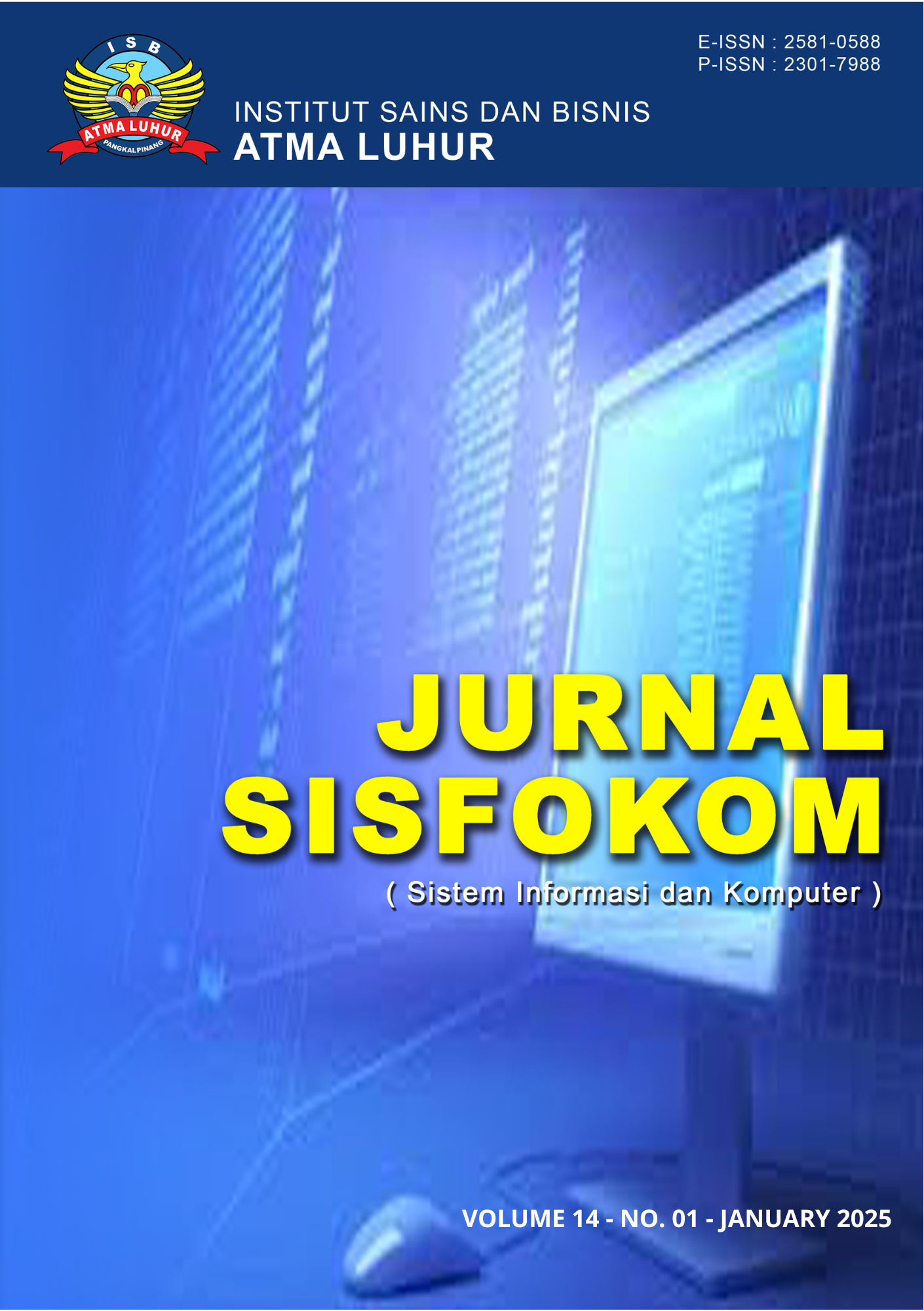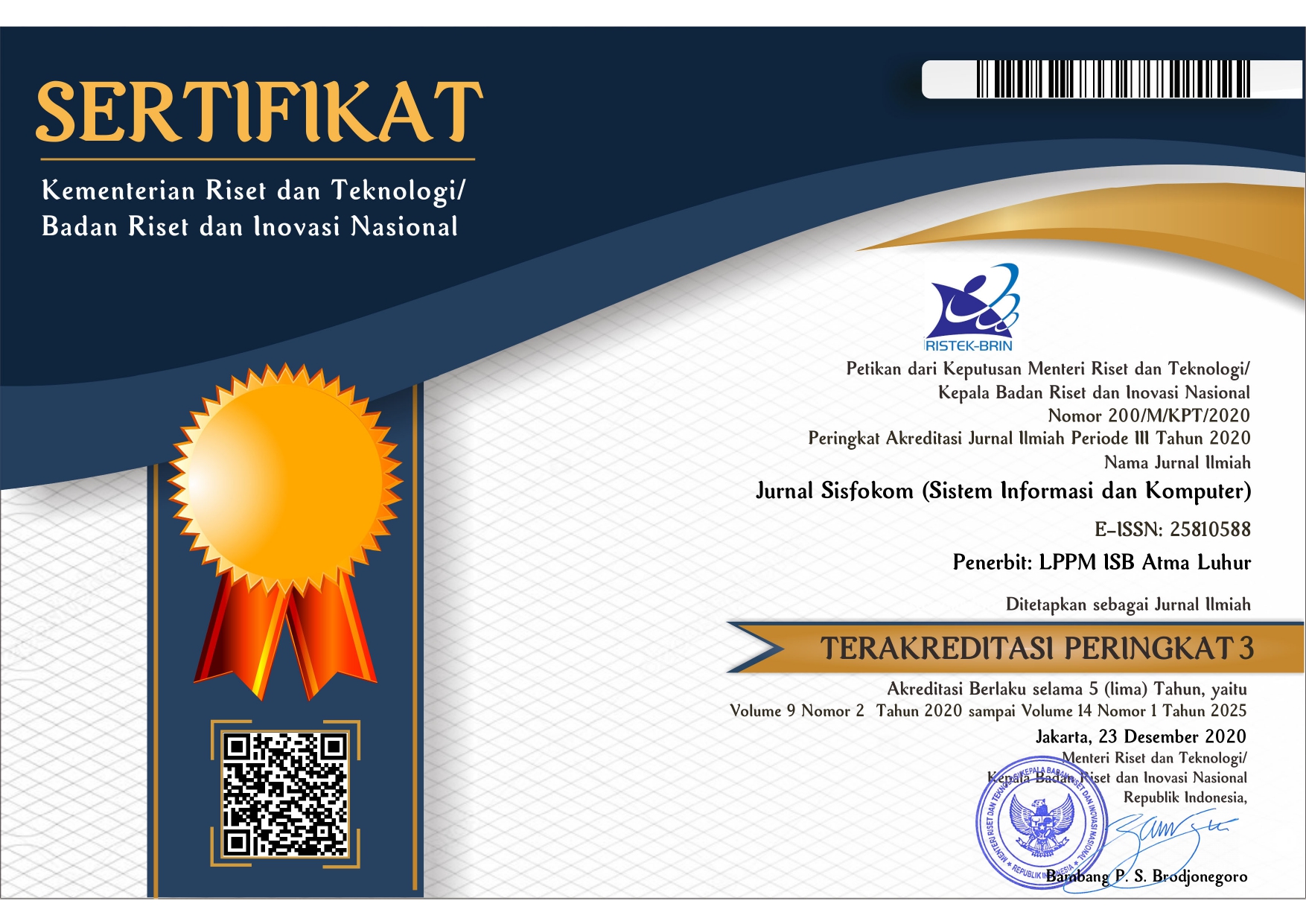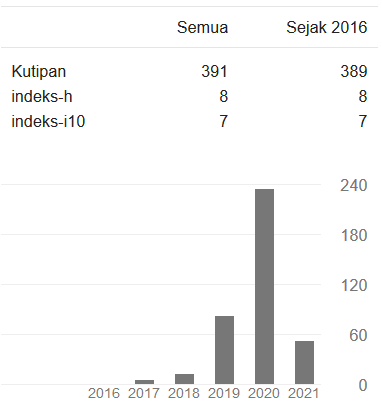The Effect of Chatbot Usage on Customer Satisfaction: A Quantitative Study of Shopee, Tokopedia, and Lazada Using SmartPLS
DOI:
https://doi.org/10.32736/sisfokom.v14i1.2312Keywords:
E-Commerce, Chatbot, User Satisfaction, Customer Service, SmartPLSAbstract
With the increasing growth of e-commerce, it is important to identify the features available in e-commerce applications that can provide customer satisfaction. One of the features in e-commerce is the chatbot. Chatbots in e-commerce can provide various services to users, such as assistance in product search, ordering, product information, payment processing, customer support, and more. This research aims to analyze and understand how the response quality of each chatbot in e- commerce platforms such as Shopee, Tokopedia, and Lazada affects e-commerce user satisfaction. This study employs a quantitative methodology, integrating data analysis conducted through the SmartPLS 4.1 software. The research results show that the chatbot in Shopee platform has a impact on customer satisfaction. The same goes for chatbot in Tokopedia platform, but there are two variables that do not have a direct impact, there are information quality and waiting time. Meanwhile, chatbot in Lazada platform does not affect customer satisfaction. The findings of this research should reveal new strategies for leveraging chatbot technology to better satisfy customers in e- commerce environments, as well as lay the groundwork for further research on how artificial intelligence can shape customer experiences in the future.References
Handayani, N. L. P. (2022). E-Commerce Sebagai Penunjang Ekonomi Digital di Jawa Tengah. Jurnal Ilmiah Manajemen, Bisnis Dan Kewirausahaan, 2(1), 9–14. https://doi.org/10.55606/jurimbik.v2i1.103.
Bawack, R. E., Wamba, S. F., Carillo, K. D. A., & Akter, S. (2022). Artificial intelligence in E-Commerce: a bibliometric study and literature review. In Electronic Markets (Vol. 32, Issue 1). Springer Berlin Heidelberg. https://doi.org/10.1007/s12525-022-00537-z.
Madasamy, S. and Aquilanz, L. L. C. (2023) ‘The Evolution of Chatbots: Cloud and Ai Synergy in Banking Customer Interactions’, Journal of Emerging Technologies and Innovative Research, 10(October 2023), pp. 127–137.
Adamopoulou, E., & Moussiades, L. (2020). An Overview of Chatbot Technology. In IFIP Advances in Information and Communication Technology: Vol. 584 IFIP. Springer International Publishing. https://doi.org/10.1007/978-3-030-49186-4_31.
Zumstein, D. and Hundertmark, S. (2020) ‘Chatbots – An Interactive Technology for Personalized Communication , Chatbots – An Interactive Technology For Personalized Communication ’, IADIS International Journal, 15(February 2018), pp. 96–109.
Trivedi, A., Gor, V., & Thakkar, Z. (2019). Chatbot generation and integration: A review. International Journal of Advance Research, 5(2), 1308–1311. www.IJARIIT.com
Sabila, A. R. and Kusumaningrum, L. (2020). Analisis Kualitas Layanan E-Commerce Shopee Dalam Meningkatkan Kepercayaan Dan Kepuasan Pelanggan (Studi Kasus: Pelanggan Shopee Di Kota Tangerang 2020). Jurnal Ilmiah Sekolah Tinggi Teknologi Informasi NIIT, 16(2), pp. 72– 80.
Dey, N., Mahelle, P., Mohd Shafi, P., Kimabahune, V. and Hassanien, A.
E. (2020) Internet of Things, Smart Computing and Technology: A Roadmap Ahead, Studies in Systems, Decision and Control.
Indah Yani, M. and Sugiyanto, S. (2022). Pengaruh Kualitas Layanan, Kepercayaan, Citra Merek Dan Kepuasan Pelanggan Terhadap Loyalitas Pelanggan Edwin Jeans Indonesia Pada E-Commerce Shopee. SINOMIKA Journal: Publikasi Ilmiah Bidang Ekonomi dan Akuntansi, 1(3), pp. 443–472.
Wibowo, B., Clarissa, H. and Suhartono, D. (2020) ‘The Application of Chatbot for Customer Service in E-Commerce’, Engineering, MAthematics and Computer Science (EMACS) Journal, 2(3), pp. 91–95.
Rita, P., Oliveira, T. and Farisa, A. (2019). The impact of e-service quality and customer satisfaction on customer behavior in online shopping. Heliyon. Elsevier Ltd, 5(10), p. e02690.
Sim, L. S., Christopher, M., Nafitra, H. D., Panjaitan, J. S. V., &
Rakhmawati, N. A. (2023). Pemilihan Platform E-Commerce Pada Kalangan Mahasiswa Its Dengan Menggunakan Metode Weighted Product. Jurnal Teknoinfo, 17(1), 36. https://doi.org/10.33365/jti.v17i1.2252.
Chong, D., & Ali, H. (2022). Competitive Strategy, Competitive Advantages, dan Marketing Performance pada E-Commerce Shopee Indonesia. Jurnal Kewirausahaan Dan Multi Talenta, 1(1), 1–13. https://doi.org/10.38035/jkmt.v1i1.7.
Sasmita, A., Ambarita, Y. M., & Putri, A. M. (2021). Strategi Pemasaran Tokopedia dalam Persaingan Antar E-Commerce dengan Analisis SWOT. Jptam, 5(2), 3397–3404.
https://jptam.org/index.php/jptam/article/view/1403
Edeh, F. O., Quttainah, M. A., Syed Badrulzaman, S. N., Kee, D. M. H., Mohd Zamri, S., Tariq Mahmud, T., Izni Shafiee, S. S., & Awoke, V. C. (2021). Factors Contributing to Online Purchase Intention amongst Malaysian Consumers: A Case of Lazada. International Journal of Accounting & Finance in Asia Pasific, 4(2), 33–45. https://doi.org/10.32535/ijafap.v4i2.1113.
Nurdiansyah, A., Pratiwi, A., & Kaunaini, B. (2022). Literature Review Pengaruh Kepercayaan, Kemudahan dan Kepuasan. Jurnal Ilmu Multidisiplin, 1(1), 297–303.
Masyhuri, M. (2022). Key Drivers of Customer Satisfaction on the E- Commerce Business. East Asian Journal of Multidisciplinary Research, 1(4), 657–670. https://doi.org/10.55927/eajmr.v1i4.405.
Pallathadka, H., Ramirez-Asis, E. H., Loli-Poma, T. P., Kaliyaperumal, K., Ventayen, R. J. M., & Naved, M. (2023). Applications of artificial intelligence in business management, e-commerce and finance. Materials Today: Proceedings, 80(xxxx), 2610–2613. https://doi.org/10.1016/j.matpr.2021.06.419.
[19] Talanquer, V. (2023) ‘Interview with the Chatbot: How Does It Reason?’, Journal of Chemical Education, 100(8), pp. 2821–2824.
Følstad, A., Araujo, T., Law, E. L. C., Brandtzaeg, P. B., Papadopoulos, S., Reis, L., Baez, M., Laban, G., McAllister, P., Ischen, C., Wald, R., Catania, F., Meyer von Wolff, R., Hobert, S., & Luger, E. (2021). Future directions for chatbot research: an interdisciplinary research agenda. Computing, 103(12), 2915–2942. https://doi.org/10.1007/s00607-021-
01016-7.
Ansari, M., & Parbulkar, M. S. (2021). Intelligent Chatbot. 9(4), 79–82.
Permata, R. A., Syaidatussalihah and Abdurahim (2023). Analisis Data Penelitian Kesehatan: Perbandingan Hasil antara SmartPLS, R dan IBM SPSS untuk Jumlah Sampel Kecil. JSN : Jurnal Sains Natural, 1(1), pp. 17–22.
Gajewska, T., Zimon, D., Kaczor, G. and Madzík, P. (2020) ‘The impact of the level of customer satisfaction on the quality of e-commerce services’, International Journal of Productivity and Performance Management, 69(4), pp. 666–684.
Hair, J.F., Hult, G.T.M., Ringle, C.M. & Sarstedt, M. 2022. Partial Least Squares Structural Equation Modeling (Pls-Sem) Third Edition. Third Edit ed. Angewandte Chemie International Edition, 6(11), 951–952., Los Angeles: SAGE Publications, Inc.
Ismawati, A. (2020). Pengaruh Kualitas Informasi Terhadap Keputusan Pembelian Produk Online Pada Shopee. Prisma (Platform Riset Mahasiswa Akuntansi), 01(06), 51–62. https://ojs.stiesa.ac.id/index.php/prisma/article/view/692.
Yolandita, C., Nursanta, E., Widiyarsih, W., & Masitoh, S. (2022). Analisis Pengaruh Daya Tarik Iklan, Kualitas Informasi, Kemudahaan dan Kepercayaan Terhadap Keputusan Pembelian Marketplace Shopee. Jurnal Sosial Teknologi, 2(6), 479–486. https://doi.org/10.59188/jurnalsostech.v2i6.343.
Maulida, N., & Jaya, U. A. (2024). Pengaruh Personalisasi dan Kecerdasan Buatan (AI) Terhadap Loyalitas Pelanggan Dalam Industri
6.0 Pada Platform E-Commerce di Sukabumi. Jurnal Ekonomi, Manajemen Dan Akuntansi, 1192, 304–317.
Zuhdi, D. A., & Yasya, W. (2023). Pengaruh Kepercayaan dan Pengalaman Pembelian Online terhadap Minat Beli di E-Commerce Shopee. Jurnal Interaksi: Jurnal Ilmu Komunikasi, 7(2), 261–277. https://doi.org/10.30596/ji.v7i2.14761.
Maulidiyah, N. F. A., Singasatia, D., & Sunandar, M. A. (2022). Analisis Pengaruh User Experience Terhadap Kepuasan Pengguna Mobile Application VLive Menggunakan Model SCSI. MALCOM: Indonesian Journal of Machine Learning and Computer Science, 2(2), 28–34. https://doi.org/10.57152/malcom.v2i2.398.
Susiyanto, D., & Naningsih. (2024). Pengaruh Artificial IntelligenceTerhadap E Business Dan E Commerce. Jurnal Ekonomi, Manajemen Dan Akuntasi, 2(1), 482–486. http://jurnal.kolibi.org/index.php/neraca.
Kapojos, A. L. N., Saerang, D. P. E., & Gunawan, E. M. (2023). the Effect of E-Service Quality and Waiting Time Towards Customer Satisfaction At Pizza Hut Restaurant in Manado Town Square. Jurnal EMBA : Jurnal Riset Ekonomi, Manajemen, Bisnis Dan Akuntansi, 11(4), 439–449. https://doi.org/10.35794/emba.v11i4.51230.
Fauzan, M., Wicaksana, M. P., & Rahardandi, P. G. (2024). Literatur Review Penggunaan Chatbot Untuk Layanan Informasi. Journal Of Social Science Research, 4(4), 8316–8323.
Ramadhani, D. R., Birawa, M. S., Sholikah, D. S., & Prabandanu, R. M.
A. A. H. (2024). Analisis Pengaruh Kualitas Pelayanan Berbasis Chatbot Terhadap Kepuasan Pelanggan Dalam Transaksi Online Dengan Objek Aplikasi Shopee. Journal of Exploratory Dynamic Problems, 1, 104–115.
Pasaribu, F., Sari, W. P., Ni Bulan, T. R. and Astuty, W. (2022) ‘The effect of e-commerce service quality on customer satisfaction, trust and loyalty’, International Journal of Data and Network Science, 6(4), pp. 1077–1084.
Song, X., Yang, S., Huang, Z. and Huang, T. (2019) ‘The Application of Artificial Intelligence in Electronic Commerce’, Journal of Physics: Conference Series, 1302(3).
Sudirjo, F., Ratnawati, Hadiyati, R., Sutaguna, I. N. T. and Yusuf, M. (2023) ‘The Influence Of Online Customer Reviews And E-Service Quality On Buying Decisions In Electronic Commerce Ratnawati 2 Politeknik Pertanian Negeri Pangkep 2’, Journal of Management and Creative Business (JMCBUS), 1(2), pp. 156–181.
Reinkemeier, F. and Gnewuch, U. (2022) ‘Designing effective conversational repair strategies for chatbots’, 30th European Conference on Information Systems (ECIS), (June), pp. 1–17.
Ingaldi, M. and Ulewicz, R. (2019) ‘How to make e-commerce more successful by use of Kano’s model to assess customer satisfaction in terms of sustainable development’, Sustainability (Switzerland), 11(18), pp. 1– 22.
Downloads
Published
Issue
Section
License
Copyright (c) 2025 Jurnal Sisfokom (Sistem Informasi dan Komputer)

This work is licensed under a Creative Commons Attribution 4.0 International License.
The copyright of the article that accepted for publication shall be assigned to Jurnal Sisfokom (Sistem Informasi dan Komputer) and LPPM ISB Atma Luhur as the publisher of the journal. Copyright includes the right to reproduce and deliver the article in all form and media, including reprints, photographs, microfilms, and any other similar reproductions, as well as translations.
Jurnal Sisfokom (Sistem Informasi dan Komputer), LPPM ISB Atma Luhur, and the Editors make every effort to ensure that no wrong or misleading data, opinions or statements be published in the journal. In any way, the contents of the articles and advertisements published in Jurnal Sisfokom (Sistem Informasi dan Komputer) are the sole and exclusive responsibility of their respective authors.
Jurnal Sisfokom (Sistem Informasi dan Komputer) has full publishing rights to the published articles. Authors are allowed to distribute articles that have been published by sharing the link or DOI of the article. Authors are allowed to use their articles for legal purposes deemed necessary without the written permission of the journal with the initial publication notification from the Jurnal Sisfokom (Sistem Informasi dan Komputer).
The Copyright Transfer Form can be downloaded [Copyright Transfer Form Jurnal Sisfokom (Sistem Informasi dan Komputer).
This agreement is to be signed by at least one of the authors who have obtained the assent of the co-author(s). After submission of this agreement signed by the corresponding author, changes of authorship or in the order of the authors listed will not be accepted. The copyright form should be signed originally, and send it to the Editorial in the form of scanned document to sisfokom@atmaluhur.ac.id.









